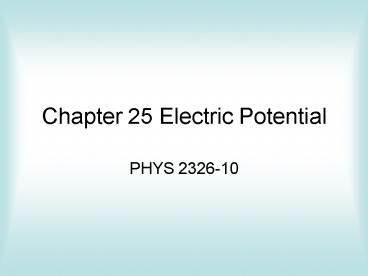Chapter 25 Electric Potential - PowerPoint PPT Presentation
1 / 22
Title:
Chapter 25 Electric Potential
Description:
4 charges q=10microC are brought to a rectangle 60cm x 15 cm. q1..q3 are fixed at the corners while qa is brought from far away to the lower left corner. ... – PowerPoint PPT presentation
Number of Views:99
Avg rating:3.0/5.0
Title: Chapter 25 Electric Potential
1
Chapter 25 Electric Potential
- PHYS 2326-10
2
Important Concepts
- Electric Work
- Electric Potential Energy
- Electric Potential
- Potential Difference
- Scalar Fields
- Vector Fields
- Gradient
- Potential Gradient
3
Electric Work
4
5
Important concepts
- Volt Joule/Coulomb
- Electric Field is
- 1Newton / Coulomb 1 Volt / meter
- Work is Force x distance moved and is the change
in energy Joules
6
Important Cases
- There are 2 important cases to know
- Uniform Electric Field
- Point charges
7
Point Charges
dr
ds
?
s
r
8
Uniform Electric Field
- E is constant and in the same direction as the
displacement s
9
Example 1chap 25 problem 17
- 4 charges q10microC are brought to a rectangle
60cm x 15 cm. q1..q3 are fixed at the corners
while qa is brought from far away to the lower
left corner. Calculate change in electric
potential energy
q2
q1
.15
qa
.6
q3
10
Example 1 point charges
- eqn 25-12 is electric potential for a set of
point charges.
11
Example 2Uniform field between 2 plates
- Chap 25.1 example
- In uniform field, eqn 25.6 applies
- E(Vb-Va)/d
- Given 2 sheets separated by 0.3cm with 12 volt
battery applying a voltage across them.
12
Example 2
- E(?V)/0.003 4.0E3 V/m
- NOTE Consistancy with units is KEY
13
Chapter 26 Capacitance
- PHYS 2326-10
14
Capacitance and Dielectrics
- We are leaving the pure electrostatic realm
- and entering electric circuits now
15
Concepts to Know
- Capacitors
- Capacitance
- Energy Density
16
Capacitance
- Capacitance is the ability for an object to hold
a charge for a given potential energy - C Q/?V
- C is the capacitance in Farads
- that can hold a charge Q with an increase in
potential of ?V volts. - 1 Farad 1 coulomb of charge per Volt
- This is a huge value
17
Capacitors
- Youre responsible for knowing
- Parallel Plate Capacitors
- Spherical Capacitors
- Cylindrical Capactors
- Typical values range from a few pico farads to a
few thousand micro farads
18
Spherical Capacitance
- eqn 26.2 provides for sphere of radius a relative
to infinity to provide - C a/k 4peo a
- example 26.2 is spherical capacitance for 2
concentric spheres of radius Ra and Rb - C 4peo Ra Rb/(Rb-Ra)
19
Parallel Plate Capacitor
- most common type of component although most are
rolled up or contain many plates - C eo A/d
- Capacitance is proportional to area /inverse
proportional to separation
20
Cylindrical
- Example 26.1 covers the cylindrical capacitance
- C 2peo L / ln(Rb/Ra)
- Where Rb is the inside radius of the outer
cylinder and Ra is the radius of the inner
cylinder and L is the length
21
Energy Stored in Capacitor
- Work done to charge a capacitor given by eqn
26.11 which is the integral of the dw required
for each dq of charge added - U ½ QV ½ C V2 Q2 /2C
- Eqn 26.13 is the concept of energy density of the
electric field - u ½ eo E2
22
Dielectrics
- Rather than k, we have used eo the permittivity
of free space - When dielectrics enter in we get a multiplying
effect of the capacitance due to the dielectric
constant ? (kappa) - such that C ?Co































